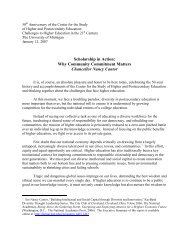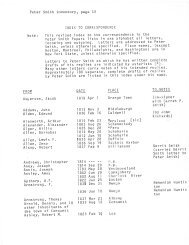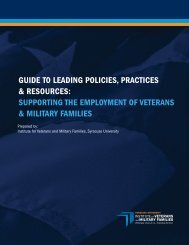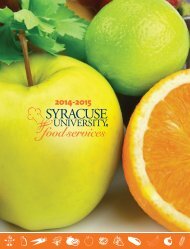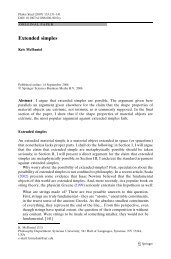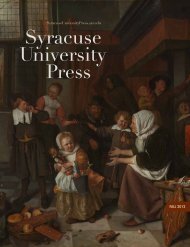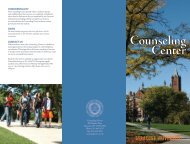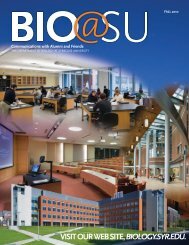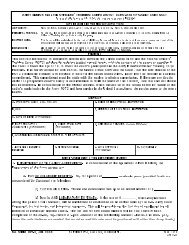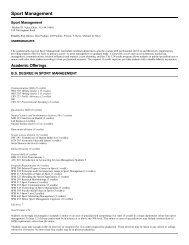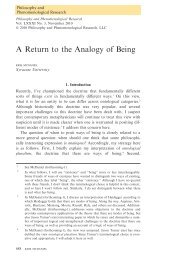Fall 2011 - the Department of Biology - Syracuse University
Fall 2011 - the Department of Biology - Syracuse University
Fall 2011 - the Department of Biology - Syracuse University
- No tags were found...
You also want an ePaper? Increase the reach of your titles
YUMPU automatically turns print PDFs into web optimized ePapers that Google loves.
Sarah, o<strong>the</strong>r internsand midwife, SafariOB ward’s medical unit. I learned I couldfunction in a hectic environment, whereresources were limited and <strong>the</strong> need wasoverwhelming. This was why I had cometo Africa—to learn, to challenge myself, tomake a small difference in <strong>the</strong> world.“That’s when I feel most alive,” PaulFarmer, <strong>the</strong> renowned doctor and anthropologist,has said, “when I’m helpingpeople.” I heard Farmer speak at <strong>Syracuse</strong><strong>University</strong>, and his remarks influencedme deeply. His muscular idealism and hispassionate belief that healing constitutesa basic human right spoke to me personally.That is why I have traveled to developingnations to do what I could with mylimited skills and have worked abroad andat home in communities <strong>of</strong> need. It’s notthat I expect to change <strong>the</strong> world, but I doexpect to make a difference in admittedlychallenging situations—whe<strong>the</strong>r it is easingmisery abroad or going up against arecalcitrant insurance company at home.In <strong>the</strong> summer <strong>of</strong> 2009, I volunteeredas a medical intern at a public clinic inCusco, Peru. While conditions were notas bare as I later encountered in Tanzania,<strong>the</strong> facility, called Belenpampa, waslocated in a dilapidated building in <strong>the</strong>center <strong>of</strong> <strong>the</strong> city and provided medicalcare to <strong>the</strong> city and outlying areas <strong>of</strong> Cusco.That lack <strong>of</strong> equipment was striking.If patients wanted a nurse to use gloveswhile examining <strong>the</strong>m, <strong>the</strong>y bought <strong>the</strong>m<strong>the</strong>mselves because <strong>the</strong> clinic could notprovide <strong>the</strong>m. I learned technical skills,such as dressing wounds and taking vitalsigns. The need <strong>the</strong>re was great. WhenendelI arrived each morning, 50 people werelined up at <strong>the</strong> admissions counter.Closer to home, SU gave me <strong>the</strong> experienceto work in two different laboratoriesin my undergraduate career. After myfreshman year, I earned a summer undergraduateinternship program at <strong>the</strong> NationalGenome Research Institute at <strong>the</strong>National Institutes <strong>of</strong> Health, working inDr. Eric Green’s laboratory on a researchproject based on comparative genomicswith chimpanzee and human X chromosomesequences.For my Honors <strong>the</strong>sis and Distinctionin <strong>Biology</strong>, I worked at SUNY UpstateMedical School with Dr. Mary Lou Vallanoin <strong>the</strong> <strong>Department</strong> <strong>of</strong> Neuroscienceand Physiology. Her current focus is oncerebral vasospasms, which are a narrowingor constriction <strong>of</strong> brain blood vesselscausing reduced blood flow to <strong>the</strong> brainand <strong>the</strong> death <strong>of</strong> neurons. They are <strong>of</strong>tenassociated with strokes resulting from nutrientdeprivation and are a complication<strong>of</strong> a subarachnoid hemorrhage. Subarachnoidhemorrhages (SAH) make up 7 percent<strong>of</strong> all strokes but are <strong>the</strong> most deadly,with more than a 50 percent fatality rate,particularly due to cerebral vasospasm. Todate, no <strong>the</strong>rapies have proven to preventcerebral vasospasm following SAH. As alaboratory, we are looking at <strong>the</strong> differentfactors that contribute to cerebral vasospasmsand trying to determine if <strong>the</strong>reis anything that can be done to decrease<strong>the</strong>ir severity and duration. Specifically,I looked at how to characterize <strong>the</strong> vasospasmmolecularly and if <strong>the</strong>re are indicatingfeatures controlling <strong>the</strong> severityand duration <strong>of</strong> <strong>the</strong> vasospasms.With graduation now over, I am excitedto take <strong>the</strong> next step. I have beenawarded an Intramural Research TrainingAward at NIH with Dr. Tom Quinn,head <strong>of</strong> <strong>the</strong> Center for Global Health atJohns Hopkins <strong>University</strong> and an activemember <strong>of</strong> <strong>the</strong> National Institute <strong>of</strong> InfectiousDisease and Allergies, and startedworking <strong>the</strong>re in July. I have learned in anup-close-and-personal way that medicineis not all about gleaming newborn babiesand happy patients. It is hard work andlong hours. Inspired by Farmer’s observationthat “no one should have to die <strong>of</strong> adisease that is treatable,” I continue on,eager to undertake <strong>the</strong> challenge <strong>of</strong> a careerin medicine.<strong>Syracuse</strong> has shown me that all <strong>the</strong>sedreams are possible. As Henry DavidThoreau once said, “If you have built castlesin <strong>the</strong> air; your work need not be lost;that is where <strong>the</strong>y should be. Now put <strong>the</strong>foundations under <strong>the</strong>m.” <strong>Syracuse</strong> <strong>University</strong>has laid <strong>the</strong> foundation. Now, all Ihave to do is keep building.W20 THE DEPARTMENT OF BIOLOGY AT SYRACUSE UNIVERSITY




